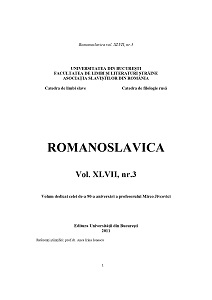Antroponime slave în satele româneşti din Banatul sârbesc central
Slavic anthroponyms in the Romanian villages of the Central Serbian Banat
Author(s): Laura SpăriosuSubject(s): Recent History (1900 till today), Historical Linguistics, South Slavic Languages, Philology
Published by: Editura Universităţii din Bucureşti
Keywords: Central Serbian Banat; Romanian village; onomastics; personal names; Slavic anthroponyms; etymology;
Summary/Abstract: As for the research about personal names of the Romanians, it should be mention that the number of professional works in this area is not large and that, when it comes to the Romanian language in the region of Vojvodina, a very small number of researches has been carried out. Having all that in mind, we decided to investigate personal names in the Romanian villages in the territory of Central Banat – Ecica, Iancaid, Sărcia, Torac, Uzdin. The material was collected from the registers of births and the analysis of all anthroponyms appearing in the period from 1900 to 2000 was carried out. The main subject of our research were the Slavic names. Related to this and on the basis of the achieved results, we could conclude that these names appeared after 1920. Since then, from 1900 till the end of World War I – in addition to the traditional names encountered among the Romanian population in these regions (Ana, Floarea, Ion, Maria, Petru, Sofia, Todor, Vioara) – a series of Hungarian and German names was also used (András, Erzsébet, Ferenc, Ibolyka, István, János, Jóska, Sándor, Hans, Klaus). Due to the fact that after 1918 they were replaced with the names of other origin, Hungarian and German names slowly disappeared. Following the colonization implemented after 1945 (settlement of the population from Bosnia), the Slavic names saw real expansion.
Journal: Romanoslavica
- Issue Year: XLVII/2011
- Issue No: 3
- Page Range: 169-179
- Page Count: 11
- Language: Romanian

